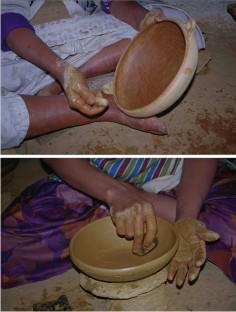Journal of Archaeological Method and Theory ( IF 3.2 ) Pub Date : 2023-01-14 , DOI: 10.1007/s10816-022-09597-z
Laure Dubreuil , Jérôme Robitaille , Jesús Gonzalez-Urquijo , Joao Marreiros , Anna Stroulia

|
The development of technologies related to plastic mineral matters (PMM), including clay, mud, and plaster, represents a major step in cultural evolution because of their important repercussions for food processing, storage, transportation, construction, and symbolic expression in past human societies. This paper aims to illuminate the chaînes opératoires employed in the transformation of PMM and highlight early evidence for these technologies in the archaeological record. Our focus is ‘ad-hoc’ (or non-manufactured) ground stone tools used in finishing operations. Specifically, we discuss pebbles and cobbles employed to regularize, smooth, or burnish clay and mud-based products. Because these tools consist of unmodified rocks, recognizing and understanding the traces developed through use is essential for their identification. This is a pilot study that draws on experiments, ethnographic studies and quantification via confocal microscopy to assess the variability of use-wear developed on mud and clay processors. Extra attention is placed on micro-polish, not only because this type of wear has been seldom described before for such tools, but also because it appears to be highly diagnostic. We suggest that the variability observed can be described as a family of wear, that is, a range of recurrent use-wear characteristics associated with the processing of PMM. We analyze two collections associated with different chrono-cultural contexts: the Late Natufian site of Hilazon Tachtit in the Southern Levant and the Late Neolithic site of Kremasti-Kilada in Greece. At both sites, the identification of processors of PMM provides pivotal data to understand the relevant chaînes opératoires, assess the emergence and development of these technologies, and also explore symbolic behaviors.
中文翻译:

一个“磨损家族”:用于抛光锅和加工其他塑料矿物的鹅卵石上的痕迹学图案
与塑料矿物 (PMM)(包括粘土、泥浆和石膏)相关的技术的发展代表了文化进化的重要一步,因为它们对过去人类社会的食品加工、储存、运输、建造和符号表达产生了重要影响. 本文旨在阐明在 PMM 转型中使用的歌剧院,并强调考古记录中这些技术的早期证据。我们的重点是用于精加工操作的“临时”(或非制造)磨石工具。具体来说,我们讨论了鹅卵石和鹅卵石,这些鹅卵石用于规范、平滑或抛光粘土和泥浆产品。由于这些工具由未经修饰的岩石组成,因此识别和理解使用过程中形成的痕迹对于识别它们至关重要。这是一项试点研究,利用实验、人种学研究和通过共聚焦显微镜进行的量化,以评估在泥浆和粘土处理器上开发的使用磨损的可变性。特别注意微抛光,不仅因为这种类型的磨损以前很少被描述为此类工具,而且因为它似乎具有很高的诊断性。我们建议观察到的变异性可以描述为一个磨损家族,即与 PMM 加工相关的一系列反复使用-磨损特征。我们分析了两个与不同时间文化背景相关的藏品:南黎凡特 Hilazon Tachtit 的纳图夫晚期遗址和希腊 Kremasti-Kilada 的新石器时代晚期遗址。在这两个站点,

































 京公网安备 11010802027423号
京公网安备 11010802027423号